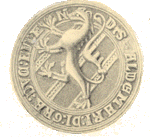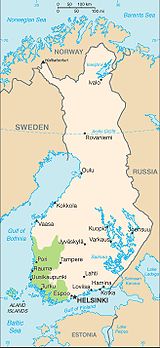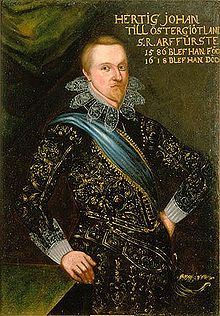- Dukes of Finland
-
Duke of Finland (in Finnish Suomen herttua; Swedish hertig av Finland) was an occasional medieval title granted as a tertiogeniture to the relatives of the King of Sweden between the 13th and 16th centuries. It included a duchy along with the feudal customs, and often meant a veritably independent principality. The title was gradually replaced by a nominal royal title Grand Duke of Finland by the early 17th century and has not been in usage since.
Contents
Medieval dukes
Bishop-Duke Kol
In the late 15th century, historian Ericus Olai claimed that bishop Kol of Linköping (d. 1196?) had been the Duke of Finland (Dux Finlandiae).[1] In the late 12th century, the title "dux" was still used in the meaning of jarl and came to mean duke only hundred years later.[says who?] Ericus Olai's claim is not supported by other sources. However, some historians date the small Stenberga Castle in Masku to the late 12th century,[2] when the Novgorodian wars reached Finland and may have resulted in temporary Swedish military presence in the area.
Noteworthy is also that the Bishops of Linköping had an unexplained connection to eastern activities during the 13th century. Pope used him in 1229 to assist the Bishop of Finland to organize the diocese, and the first known Duke of Finland, Benedict, was soon after his nomination elected also as the Bishop of Linköping. Bishop of Linköping had also accompanied the Swedish ledung on their unsuccessful Estonian expedition.
Bishop-Duke Bengt Birgersson
Main article: Benedict, Duke of FinlandBengt Birgersson (1254–91), also known as Benedict, an eccleasiastic, the youngest brother of king Valdemar I of Sweden and Duke Magnus of Sweden (later king Magnus III), was about 1284 granted the Duchy of Finland by his elder brother king Magnus. Bengt's appointment ended a 35-year-long period of episcopal rule in Finland, effective since the Second Swedish Crusade around 1249.
Bengt's reign did not last long. Soon thereafter, the duke, a consecrated priest and the chancellor of the realm, was elected in 1286 bishop of Linköping. As far as is known, he bore revenues from Finland until his death but did not attempt any independent rule. He was the first known holder of the appanage of Finland.
Duke Valdemar
Main article: Valdemar, Duke of FinlandThe youngest son of the late king Magnus III of Sweden (1240–90), Valdemar (1280s-1318), was given his late uncle Bengt's Duchy of Finland at the coronation of his eldest brother King Birger I of Sweden in 1302. Valdemar's elder brother Duke Eric was in the 1310s establishing a truly independent principality in Western Sweden, duke Valdemar being his ally. There is no evidence that duke Valdemar succeeded in having as independent position as his brother, but it is obvious that Valdemar used his ducal revenues to assist Eric's campaign against the king and kept his Finnish appanage and administration under Eric instead of the king.
In 1315, in alliance with Eric, Valdemar gained Turku castle and Häme Castle together with their provinces, i.e. most of Finland, as well as Stockholm Castle, most of Uppland and Borgholm with Öland, as the result of their civil war against the king. On December 10, 1317 he was imprisoned in Nyköping together with his brother Eric by their brother Birger. Sometime in 1318, Duke Valdemar (and Duke Eric) died while incarcerated.
With his second wife Ingeborg of Norway, Duke Valdemar had a son, born in 1316, who presumably died young.
Duke Bengt Algotsson
Main article: Benedict, Duke of HallandBengt Algotsson (1330–60), whom his alleged homosexual lover King Magnus IV of Sweden (nephew of Duke Valdemar, above) had already in 1353 recognized as Duke of Halland (an originally Danish principality) as the heir of its earlier dukes, Dukes of Estonia and Reval, was in 1353 or 1354 given the duchy of Finland, too.
The duke apparently did not make any bigger efforts to establish himself as ruler in Finland, being satisfied to bear revenues from the duchy. He had his seat in Southern Sweden, where he acted as Viceroy of Skane.
The duke was trampled under certain nobility's opposition against the king. He was exiled in 1357, and killed without an heir in 1360. In 1357, his holdings, including Finland, were given to Eric. Eric was co-ruler of the king, and did not need the ducal title which was left aside for almost 200 years.
Duke John: From duchy to grand duchy
Main article: John III of SwedenIn 1556, two hundred years after it was vacated by deposition of Duke Bengt Algotsson, King Gustav I of Sweden (reigned 1523–60) gave the duchy of Finland to his second son, the then 18-year-old John (1537–92). John was the only holder of the title to establish a real princely rule in Finland. The duchy included the Finland Proper, Raasepori together with Western Uusimaa, and Lower Satakunta. The duchy thus formed was given extraordinarily independent feudal rights by the king. Additionally, John was appointed as Governor-General of Finland, meaning all the other areas beyond Gulf of Bothnia and up to the eastern border. These additions he however did not hold by feudal right but as a royal appointee.
Duke John settled in Turku, where he created a cultivated princely court at the Turku castle. John was an enthusiastic patron of arts and architecture, and he decorated the castle to splendor never before seen in Finland. Before his marriage, he had a Finnish mistress, Kaarina Hannuntytär. Several Finnish and Swedish families claim descendancy from their bastards. After the death of his father, John drove his own foreign policy which at times was at odds with his elder brother King Eric XIV of Sweden (reigned 1560–68). Also in domestic affairs, John soon opposed the king, together with a party of high nobility who all opposed the increasing centralization of the government. On October 4, 1562, John married his first wife Catherine Jagellonica (1526–83), daughter of Sigismund I of Poland (1467–1548), against the wishes of his elder brother. Eric regarded his conduct as a rebellion. John and Catherine were imprisoned to Gripsholm Castle in 1563, after a siege of the Turku castle and its conquest by king's troops. The imprisoned duke kept his title, but the duchy itself became administered by royal officials.
Eric was deposed by leaders of nobility in 1568, and John, recently released, ascended the throne of Sweden. He reigned until his death in 1592 as King John III. Apparently he made, in 1589, arrangements to grant the Duchy of Finland to his youngest son Duke John (see below).
In 1581, King John III assumed the subsidiary title Grand Prince of Finland and Karelia.[3] "Karelia" was soon dropped from the title and assumed a part of Finland, which thus started to have its later eastern extent. The title became established in Latin renderings, and later in the 19th century also in English, as the Grand Duke of Finland, however using the Finnish (ruhtinas) and Swedish (furst) names for a prince in its local renderings.
Late titular use
Before fully demolished, there was a brief titular use of Duke of Finland among the royal family.
John the Younger
Main article: John, Duke of ÖstergötlandShortly before his death, King John III, the previous Duke of Finland, gave his old Duchy and its title as a royal duke to John the Younger (1589–1618), his newborn son from his second marriage with Gunilla Bielke (1568–97). King Sigismund III, child John's half-brother, seems to have confirmed this appanage.
Royal chancellery administered the duchy on behalf of the underage duke, and provided him his allotted revenues. However, when young Duke John approached adulthood, his duchy was in 1606 changed to that of Östergötland, previously held by King John's brother, the late Duke Magnus. Duke John the Younger married his first cousin Maria Elisabeth of Sweden (1596–1618). They died childless.
During 1590-1599, John's father and half-brother continued to call themselves Grand Dukes of Finland. [4]
Gustav Adolf
Main article: Gustav II Adolf of SwedenCrown Prince Gustav Adolf (1594–1632), elder son of Charles IX of Sweden, the heir-apparent, was in 1606 made Duke of Finland, upon assigning Östergötland to Duke John the younger, and started to receive ducal revenues from Finland.
Gustav Adolf ascended the throne of Sweden in 1611 and readopted[5] the Grand Duke of Finland among his titles. He was the last to have a real feudal principality of Finland and revenues therefrom.
List of Dukes and Duchesses of Finland
Includes Swedish Lords of Finland by other titles.
- Benedict, Duke of Finland 1284-1291 (also Bishop of Linköping)
- Prince Waldemar, Duke of Finland 1302-1318 (also 1310-1318 of Uppland and Öland)
- Christina (daughter of Lord Thorchetel), Duchess of Finland 1302-1305 as consort of Prince Waldemar
- Princess Ingeborg, Duchess of Finland 1312-1353 as second consort of Prince Waldemar
- Benedict, Duke of Finland 1353-1357 (also of Halland)
- Ex-King Carl, Lord of Finland 1465-1467, then (again) King Carl II (VIII) of Sweden
- Prince John, Duke of Finland 1556-1563, later King John III of Sweden
- Princess Catherine, Duchess of Finland 1562-1563 as consort of Prince John, later Queen of Sweden
- Prince John, Duke of Finland 1589-1607 (also of 1606-1618 of East Gothland)
- Crown Prince Gustav Adolph, Grand Duke of Finland 1607-1611 (also Duke of Södermanland, Estonia and Västmanland, then King Gustav II Adolph of Sweden
- Prince Carl Gustav, Great Prince of Finland 1805-1805, son of King Gustav IV Adolf of Sweden
No duke of Finland has left descendants in marital lines which survive to our time. Except John III's legitimate descent (kings of Sweden and Poland and totally extinct since 1672), lineage of all the others went extinct upon their own death or at the death of an only surviving legitimate child.
See also
- Monarchy of Finland
- Grand Duchy of Finland
- Dukes of Swedish Provinces
- List of Finnish monarchs
- Governor-General of Finland
External links
References
- ^ Suomen Museo 2002. See page 66. The book can be ordered from the Finnish Antiquarian Society.
- ^ Virrankoski, Pentti. Suomen historia I. ISBN 951-746-321-9. See page 66.
- ^ Klinge, Matti: Suomen sinivalkoiset värit. Kansallisten ja muidenkin symbolien vaiheista ja merkityksestä. Third edition. Keuruu 1999. See pages 246-247.
- ^ See Titles of European hereditary rulers.
- ^ The title had not been used by his father King Charles IX, who had added "King of the Finns" to his long list of titles in 1607.
Categories:- Medieval Finland
- Sweden–Finland
- Rulers of Finland
- Dukedoms
- Lists of dukes
Wikimedia Foundation. 2010.





